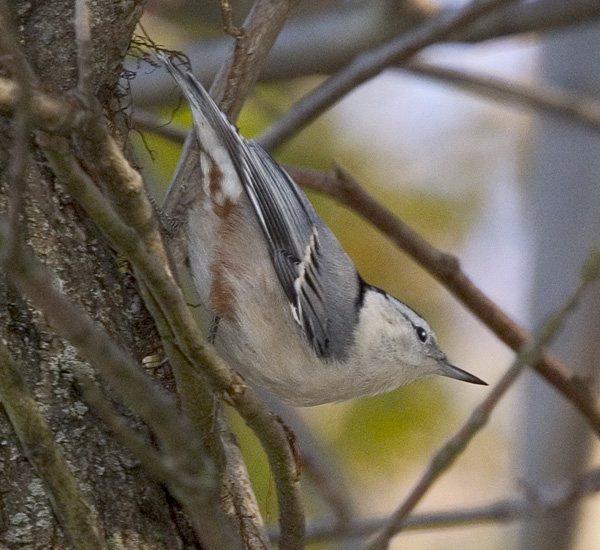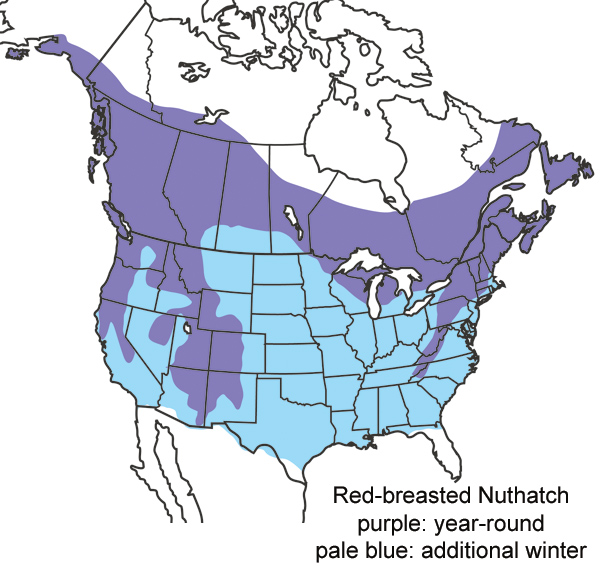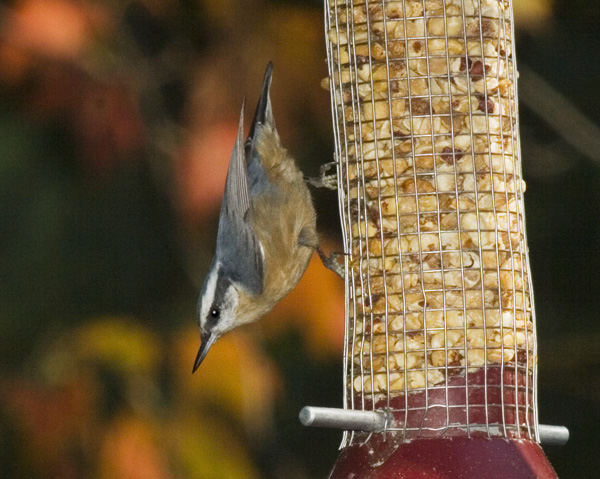Inverted Invaders
We could call them “nutcases” instead of “nuthatches,” and we wouldn’t be far off. Nuthatches don’t hatch nuts; they run around on trees, clambering up, clambering down headfirst, making nasal or squeaking notes. They act as if they’ve spent too much time upside down, permanently warping their brains.
For all their clambering around, nuthatches in general don’t really go anywhere. There are about two dozen nuthatch species scattered around North America, Europe, Asia, and North Africa, and most of them are studiously non-migratory. The most common representative in North America, the White-breasted Nuthatch, is found throughout the year virtually throughout its range. Small southward movements are sometimes detected in fall, but the only change in distribution that results is that a few show up in the southern Great Plains, away from nesting sites.
Of all the nuthatch species, only one engages in really long-distance movements, and that is the Red-breasted Nuthatch of North America. It nests mainly in coniferous forests of Canada and of the higher mountains in the USA, and a few can be found all winter throughout most of the breeding range. But others will migrate, showing up many hundreds of miles farther south. The numbers that invade southward are highly variable from year to year. In some winters, it seems that every grove of evergreens in the lower 48 states will have one or two of these little birds climbing around the branches. In other winters, they are scattered and hard to find.
Why is Red-breasted Nuthatch, unlike all its cousins, so prone to long-distance movements? Apparently it’s a matter of diet. In the cold forests of the far north and the high mountains, these birds feed heavily on the seeds of coniferous trees in winter, especially those of spruces. Spruce cone crops are quite variable from year to year, and when the cone crops fail, many Red-breasted Nuthatches move south looking for other kinds of food. Their dispersal behavior is really more like that of the “winter finches” such as crossbills, siskins, and redpolls.
Fall 2010 has shaped up to be a fairly good season for these birds. When Kimberly and I were in the mountains of eastern Tennessee in early September, we ran into quite a concentration of RB Nuthatches up at Carver’s Gap. These birds could have come from nearby, since they nest far south in the Appalachians. But when we returned to Ohio, we found that a few nuthatches had arrived in our town of Oak Harbor. At least one female is still making numerous raids on our bird feeders every day.
Because Red-breasted Nuthatches move around so much, they sometimes show up in odd places. A couple of times I have been on birding boat trips on the ocean, out of sight from land, and have seen single nuthatches come flying in to land on the boat – this happened to me once in California and once in New Jersey. But some individuals go even farther afield. A Red-breasted Nuthatch showed up in Norfolk, England, in October 1989 and stayed for seven months, creating a sensation and attracting many thousands of birders.
If you’re a birder in North America, do you have Red-breasted Nuthatches around in your usual birding spots? If you’re a birding in the UK, did you get to see the famous vagrant nuthatch in 1989-1990?


![WBNUmap [Converted] White-breasted Nuthatch. Map by Kenn Kaufman.](https://birdingblogs.com/wp-content/uploads/2010/11/WBNUmap_KennKaufman.jpg)


Hi Kenn, another UK Red-breasted Nuthatch would be very popular! There’s also a record from Iceland. Perhaps there’s a pine plantation somewhere in the UK holding one as I type… Hope so!
I was glad to see this article. I’ve had the first ever Red-breasted nuthatches in my yard this year, east TN Valley, Knoxville, at the foot of the Smokies. He came to the feeder again today and I’ve seen lots of reports on TN Bird. I have been delighted. Still trying to get a good photo image!
We have them year-round in Ottawa, Ontario, although in some invasion years they are quite scarce, having gone south. It may delight your southern readers to know that this species will readily take peanuts from the hand!
We have RB Nuthatches year round in Idaho, even in the more mature parts of downtown Boise. I have been seeing several of them this fall in Virginia and North Carolina. I figured they were year round there, but it will be interesting to start following their arrivals and departures.
This has been a good season for RB nuthatches in my back yard in Grosse Pointe, Michigan. They have been regularly visiting my suet feeders and peanut feeders for about a month or so and are seemingly increasing in number every week, along with a regular crew of WB nuthatches. I was worried that the RB nuthatches would have difficulty fighting off the sparrows on the peanut feeder but they zip in and out quickly, getting their share. They look healthy, like they had a good summer.
I saw my first Red-breasted Nuthatches of the season this weekend at Winton Woods (in Cincinnati). At least 6 were in sight. Last year one visited my yard for three days…I’m keeping my fingers crossed for this winter.
For several weeks, two red-breasted nuthatches have come to my feeder daily in Charlottesville, VA.
I have yet to see any RB Nutcases. I have the whiteys all over the place. I must live a little south for them, but I’m sure I’ll see one some day in the future. A couple of good shots in this post. Good read.
-Backyardbirdgardner.wordpress.com (Chip)